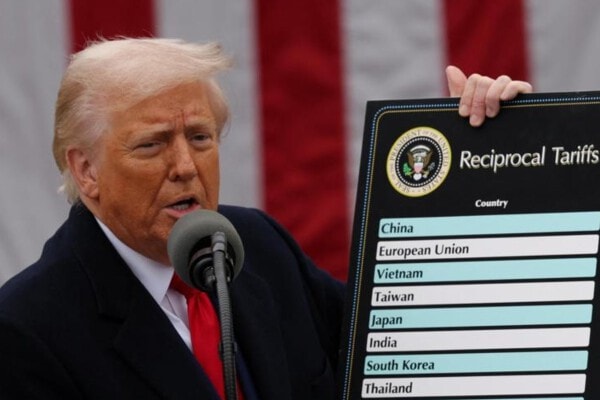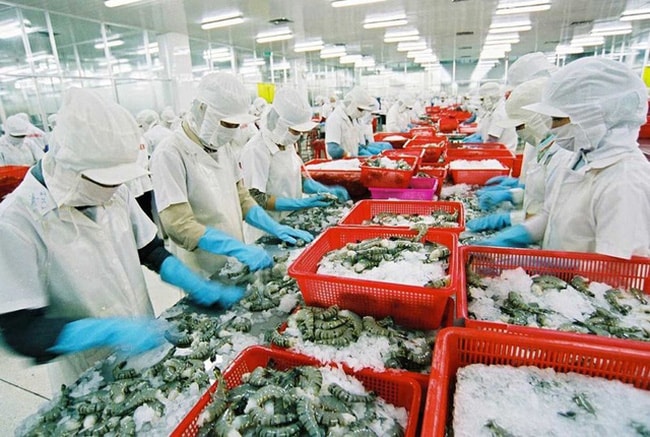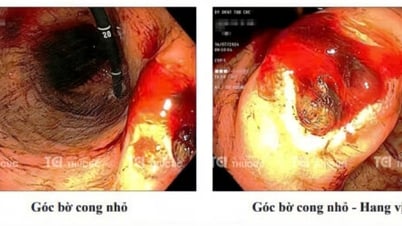Because they cannot compete on price, Vietnamese shrimp processing and exporting enterprises must focus on tax-free products, deeply processed products with high added value to survive in the US. According to experts from VinaCapital, the 46% reciprocal tax rate is only the starting point in the negotiation strategy. Vietnam needs to urgently import more goods from the US.
Vietnam should import more goods from the US.
On the morning of April 3, 2025 (Vietnam time), the administration of US President Donald Trump announced a reciprocal tax rate of up to 46% on Vietnamese goods exported to the US. According to many analysts, the application of this tax rate will affect Vietnam's GDP growth.
Commenting on this issue, Mr. Michael Kokalari, CFA - Director of Macroeconomic Analysis and Market Research at VinaCapital, said that applying this tax rate will affect Vietnam's GDP growth, because the market previously expected a reciprocal tax rate of only 10% for Vietnam.
According to the White House, Vietnam is imposing a tariff of up to 90% on imports from the US, including factors such as “currency manipulation and trade barriers”. However, this 90% figure is calculated by dividing the US trade deficit with Vietnam by total imports from Vietnam. Specifically, take the US$123 billion trade deficit with Vietnam in 2024 and divide it by the US$137 billion import turnover of goods from Vietnam to the US.
This calculation matches the “tariffs on imports from the United States” figure that President Trump gave at the press conference announcing the countries’ tariffs. The trade deficit and import figures were taken directly from Appendix II of the USTR report released the previous day.
At the same time, this calculation also reflects the spirit of President Trump's previous statements that countries with large trade surpluses with the US are "taking advantage" of the US and therefore they have built their entire tariff policy based on trade balance figures — or at least used that number as the basis for their initial stance in upcoming negotiations.
Therefore, according to Mr. Michael Kokalari, Vietnam urgently needs to import more goods from the US. "Previously, we heard from secondary sources that Trump administration officials appreciated Vietnam's initial efforts to reduce the bilateral trade deficit, but they will not accept promises to buy in the future as before," he said.

The expert also said that there is positive news in the energy industry when Vietnam will quickly import about 35 billion USD of liquefied natural gas (LNG) per year using Floating Storage Regasification Units (FSRU) because the construction of LNG ports may take many years.
In addition, the initial reaction of trade negotiation experts is that this morning's 46% reciprocal tax rate is just the starting point in the Trump administration's negotiation strategy and that negotiations between Vietnam and the US are expected to take place in the coming weeks on this issue.
However, even among experts, there is no consensus on the final tariff level that Vietnam could face. With Mr. Trump setting a very high starting point in the negotiations, it is difficult to imagine that the final figure could be lower than 25% – and this would be a factor affecting Vietnam’s GDP growth this year.
Experts from Vinacapital assessed that investors and large enterprises in the US did not expect the tax rate on goods exported from Vietnam to the US to be significantly higher than 10%, and did not increase imports from Vietnam before the tax rate was announced, but increased imports from China and cars from the EU.
On the stock market, the VN-Index fell nearly 7% in today’s session, with selling pressure spreading across the entire market, showing that investors still need more time and information to assess the real impact of this policy on the economy and profit growth of listed companies. For example, shares of FPT – a software outsourcing service provider – fell by 7% (floor price) even though the Trump administration’s tax rate has no impact on the company’s products.
In the foreign exchange market, the initial reaction of the USD/VND exchange rate was relatively mild, with the USD/VND exchange rate losing less than 1% on the news – and a total of less than 2% year-to-date. Based on the experience of President Trump’s first term and other cases (such as Mexico), the foreign exchange markets of countries that are subject to tariffs typically see their currencies depreciate by about half the amount of the tariffs imposed.
In fact, the fluctuations in the USD/VND exchange rate reflect the fact that many details are still unclear – including the possibility of “carve-outs” for some specific items that Vietnam exports to the US.
In terms of investment strategy, he assessed the impact of the tax rate on the scenarios set for different investment portfolios, and is looking for buying opportunities on short-term stock price declines amid the potential long-term impact on both the Vietnamese and global economies. This sell-off creates opportunities for active fund managers to buy stocks with good fundamentals and less direct impact from tax policy, at more attractive valuations.
The most obvious beneficiaries are those that will benefit from the government’s efforts to offset the impact of tariffs on GDP growth. In February, the government announced an increase in its already ambitious public investment spending plan for this year, and the news of the US tariff policy will further strengthen its determination to promote these domestic stimulus measures, he said.
Focus on non-taxed products, deeply processed products
Meanwhile, speaking to the press, Mr. Pham Van Viet, Chairman of the Board of Directors of Viet Thang Jean Limited Liability Company, Permanent Vice Chairman of the Ho Chi Minh City Textile, Embroidery and Knitting Association, said that of the total of more than 44 billion USD of Vietnam's textile and garment exports in 2024, the US market accounts for 40%, equivalent to 18 billion USD.
Currently, the average tax rate for Vietnamese textiles exported to the US is 15-16%, depending on the type of product. Thus, if the US actually applies a reciprocal tax rate of up to 46% as announced, Vietnamese textiles will be subject to an average tax rate of 61-62% when entering the US. Thus, US consumers will also be affected in the context of high inflation.
According to Mr. Pham Van Viet, on April 2, businesses had to hold many urgent meetings with relevant parties to discuss response plans. In the immediate future, businesses are trying to speed up the delivery of shipments that are due to be delivered to the port, negotiating with shipping lines to let the goods leave the port before the new tax rate takes effect to apply the old tax rate. However, this plan is likely to encounter obstacles when goods from everywhere flock to the US in the coming days, before the new tax rate is implemented.
Businesses that still have pre-signed orders but have not yet reached the delivery deadline will contact their partners to discuss how to handle the situation in order to harmonize the interests of both parties. Certainly, when the new tax rate is applied, purchasing power will decrease by at least 50%, and importers in the US will also be under great pressure. Therefore, businesses must flexibly share orders in the second quarter to other markets, exploiting niche markets to release goods at risk of congestion.
“The industry association will quickly recommend that the Government negotiate with the US government to reduce the reciprocal tax rate to the lowest possible level. To improve the situation, Vietnam should reduce import tax and increase purchases of US goods such as automobiles, electronic equipment, aircraft, agricultural products, food, etc. Basically, the export product structure of Vietnam and the US do not compete directly with each other; therefore, reducing import tax on US goods does not greatly affect domestic production. It is important that solutions be implemented as soon as possible because if the announced tax rate is applied, Vietnamese export enterprises will face many difficulties," Mr. Pham Van Viet proposed a solution.

Similarly, Mr. Ho Quoc Luc, Chairman of the Board of Directors of Sao Ta Food Joint Stock Company (a company specializing in processing and exporting shrimp), shared that although he had anticipated it, the news that US President Donald Trump had imposed a reciprocal tax rate of up to 46% on Vietnamese imports surprised the business community. Because in recent times, the Vietnamese Government has made many efforts and taken specific actions to make the Vietnam-US trade balance more and more balanced.
“It is still unclear how the new reciprocal tax rate will be applied to each item, but it is clear that both Vietnamese businesses and American consumers will find it difficult to bear the increased costs. Given this situation, businesses hope that the Vietnamese Government will soon have a plan to negotiate with the US government so that the reciprocal tax rate will be reduced to an acceptable level," Mr. Ho Quoc Luc added.
Statistics from the Vietnam Association of Seafood Exporters and Producers show that in recent years, Vietnam has ranked 4th among shrimp suppliers to the US market with a stable market share of about 8%; behind India with a market share of 31%, Ecuador with 26% and Indonesia with 17%. Vietnamese shrimp is expensive and almost unable to compete in price with shrimp from India and Ecuador.
Because they cannot compete on price, Vietnamese shrimp processing and exporting enterprises must focus on tax-free products, deeply processed products with high added value to stay in the US market.
In the upcoming case that the US applies higher import tax on Vietnamese shrimp, the problem will not only be price competition between suppliers but also the consumption of high-value products such as shrimp by Americans will decrease sharply due to high prices.
The US market is also the largest customer of the Vietnamese wood and furniture industry, accounting for 55% of total annual export turnover. Mr. Huynh Le Dai Thang, Director of Nghia Son Furniture Limited Company, informed that the US currently accounts for 50% of the company's export turnover, the remaining 50% is exported to Europe.
The news that the US is imposing reciprocal tariffs on Vietnamese goods has made businesses worried, but Mr. Huynh Le Dai Thang also shared: “Currently, businesses in the industry have petitioned the Government to negotiate with the US on the tax rate for wooden products and are waiting for positive results. While other industries are quite passive, before the US announced the reciprocal tariff, Vietnamese wood industry businesses were aware of the need to balance trade. Accordingly, export businesses actively imported raw wood from the US and also petitioned the Government to reduce taxes on all types of raw materials and wood imported from the US to Vietnam to 0%. This is considered the basis for the US to consider a reasonable tax rate for Vietnamese wood products."
Faced with the US applying a basic tax rate of 10% on all imported goods and corresponding tax rates on a series of major trading partners, many Vietnamese enterprises and export industries have planned to shift their supply chains by increasing purchases of raw materials from the US and diversifying consumption markets. However, in the context of a constantly changing world, expanding to new markets is not easy and takes more time./.
Source: https://baodaknong.vn/giai-phap-nao-giup-doanh-nghiep-viet-ung-pho-sau-khi-my-ap-thue-doi-ung-248285.html


![[Photo] Magical moment of double five-colored clouds on Ba Den mountain on the day of the Buddha's relic procession](https://vphoto.vietnam.vn/thumb/1200x675/vietnam/resource/IMAGE/2025/5/9/7a710556965c413397f9e38ac9708d2f)





















![[Photo] General Secretary To Lam begins official visit to Russia and attends the 80th Anniversary of Victory over Fascism](https://vphoto.vietnam.vn/thumb/1200x675/vietnam/resource/IMAGE/2025/5/8/5d2566d7f67d4a1e9b88bc677831ec9d)





































































Comment (0)